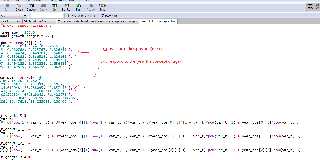|
 |
"Bald Eagle" <cre### [at] netscape net> wrote:
> "And" <49341109@ntnu.edu.tw> wrote:
>
> > > However, one very important thing is the way decimals are written to the
> > > example include files. My system uses 'dots' (example: 3.9432) instead
> > > of 'commas' (example: 3,9432) like is done by your app. I guess that
> > > some countries/systems do so standard, but not all.
> >
> > I use 'meter' as the length unit, so that output result is caused by my habit.
> > The dots are decimal points.
>
> Units don't appear to be the issue. The representation of decimal fractions is
> what Thomas is concerned about.
>
Labeling titles and units on diagram is important I know. I will label them.
> > I want to ask a question, a number contain commas can be read as 'one' number
> > correct by POV-Ray?
> > Can 3,9432 be a number?
>
> Nope. That would be a string. AFAIK, all versions of POV-Ray use only numerals
> and the "+,-, and ." glyphs to represent numerical values. Formatting those
> values using str and probably a macro would be necessary to show the usual
> commas between every step of 10^3.
>
>
> > > If this is an issue for better international use, could you make
> > > this an initial choice to make by the user? Or is there another way to
> > > change this easily?
> > >
> > > --
> > > Thomas
> >
>
> I think he means "Is there a way to specify whether to use "," or "." for the
> data's output format.
I'm not clear this time. POV-Ray cannot use a number contains commas as you
said, why I need add commas between every step of 10^3. I attach a picture, this
picture is what I saw on my output data. Is the same format on your output data? net> wrote:
> "And" <49341109@ntnu.edu.tw> wrote:
>
> > > However, one very important thing is the way decimals are written to the
> > > example include files. My system uses 'dots' (example: 3.9432) instead
> > > of 'commas' (example: 3,9432) like is done by your app. I guess that
> > > some countries/systems do so standard, but not all.
> >
> > I use 'meter' as the length unit, so that output result is caused by my habit.
> > The dots are decimal points.
>
> Units don't appear to be the issue. The representation of decimal fractions is
> what Thomas is concerned about.
>
Labeling titles and units on diagram is important I know. I will label them.
> > I want to ask a question, a number contain commas can be read as 'one' number
> > correct by POV-Ray?
> > Can 3,9432 be a number?
>
> Nope. That would be a string. AFAIK, all versions of POV-Ray use only numerals
> and the "+,-, and ." glyphs to represent numerical values. Formatting those
> values using str and probably a macro would be necessary to show the usual
> commas between every step of 10^3.
>
>
> > > If this is an issue for better international use, could you make
> > > this an initial choice to make by the user? Or is there another way to
> > > change this easily?
> > >
> > > --
> > > Thomas
> >
>
> I think he means "Is there a way to specify whether to use "," or "." for the
> data's output format.
I'm not clear this time. POV-Ray cannot use a number contains commas as you
said, why I need add commas between every step of 10^3. I attach a picture, this
picture is what I saw on my output data. Is the same format on your output data?
Post a reply to this message
Attachments:
Download 'radial_speed_output.png' (96 KB)
Preview of image 'radial_speed_output.png'

|
 |




![]()